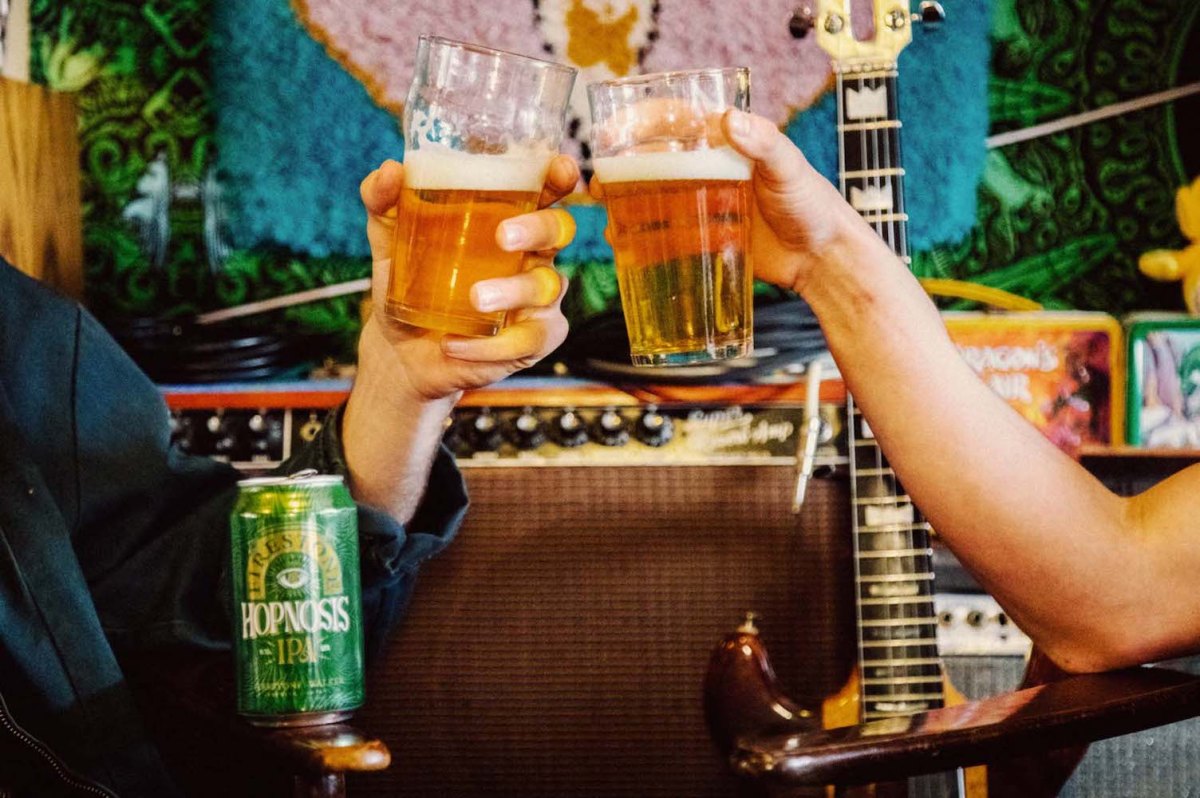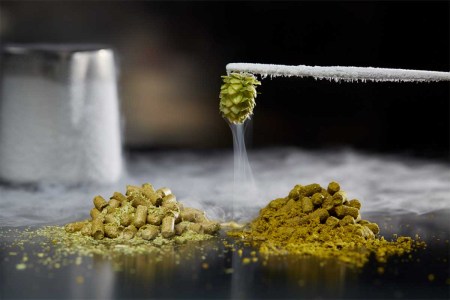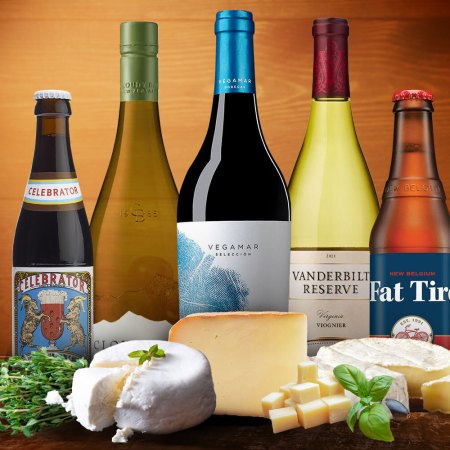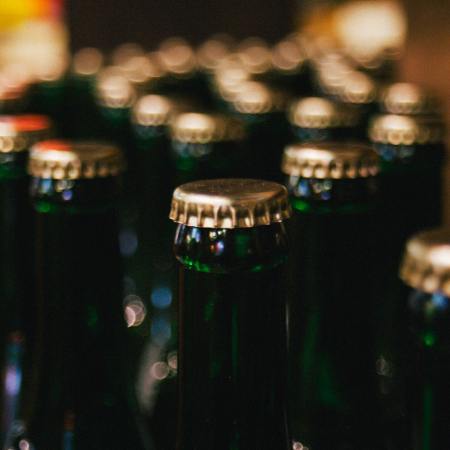Hey there… sorry for the interruption. Before you dive into this article, we just wanted to quickly let you know that we now have a new weekly newsletter devoted solely to drinks and drink culture called The Spill. If this seems like it might be up your alley, please go here and sign up. We think you’ll like it.
During the past couple of years, beer drinkers, especially on the West Coast, have likely been seeing a new type of IPA pop up on draft lists: the cold IPA. The style was officially coined in 2017 by Kevin Davey at Wayfinder Beer in Portland, Oregon. Today, as more and more breweries make their own versions, it’s proven to be an IPA that’s perfect for our time.
“I loved California West Coast IPA when I first started in the industry,” Davey told Craft Beer & Brewing Magazine podcast in 2021. “And so I’m like, ‘What if we just take that further? Let’s make it even clearer. Let’s make it even less caramel-y. Let’s make it even drier.’ That’s why — on the can — we say it’s ‘wester than West Coast’ because we’re taking all the things that are already West Coast and we’re just pushing them a little bit further.”
It can feel at times like the whole craft beer industry has revolved around making small changes on the ever-popular IPA. Cold IPAs fall into the category of yet another iteration, which reasonably led to initial skepticism from some brewers.
“I heard about Cold IPAs around December of 2021 and originally dismissed them as a cool way of rebranding IPL [India Pale Lager],” says Tomas Barrios, head brewer at Cheluna Brewing in Aurora, Colorado. After trying a cold IPA from Westbound & Down, Barrios had a change of heart and now offers a cold IPA as a permanent rotating option.
“Admittedly, this new IPA style sounded a bit ambiguous,” says Michael Palmer, the lead innovation brewer at Sierra Nevada Brewing Company who led the research and development for the limited-run Cold Torpedo IPA in 2022. Then he tried one from 12 Bones Brewing in Asheville, North Carolina, and a week or so later started developing one for Sierra Nevada. Tyler Bies, lead brewer at Joyride Brewing Company in Edgewater, Colorado, had a similar experience in 2021 and tried his hand at brewing a version in 2022 that ended up being perfect for a hot summer day.
Barrios adds that, from both a drinker and a brewer perspective, cold IPAs hit two popular trends right now: hops and lighter beer. “In a way, craft beer drinkers are having their cake and eating it too with cold IPAs,” he says.
Davey wasn’t the first one to put big hop characteristics into a light bodied beer. Firestone Walker Brewing Company released the dry hopped pilsner Pivo Pils in 2012 when Davey was working as a brewer there. Easy drinking yet hoppy beers have gone by a few different names in the past decade. There was the short-lived brut IPA, which borrowed a wine term to signify that it was dry. West Coast pilsner was sometimes used to describe the body of a pilsner with the hop focus of a West Coast IPA. IPL — swapping the “a” for ale with an “l” for lager — is another one that has had slightly more staying power. However, cold IPA is shaping up to be the perfect version of these different takes on the style.
“There had been enough work being done on lager yeast IPAs prior that it wasn’t a shock to my system,” says Firestone Walker master brewer Matt Brynildson. “Cold IPA — it sounds appealing and it reflects what that beer is in a simple way. It’s brilliant in that consumers can relate to it” in a way that wasn’t achieved with brut IPA, IPL or West Coast pilsner.
The IPAs that first made the category explode in popularity in the early 2000s used caramel and Munich malts that had a lot of both flavor and color. Sierra Nevada’s Celebration Ale, Bell’s Two Hearted and Pliny The Elder from Russian River Brewing Company largely defined what an American IPA meant. Now, pale is in.
“In the past 10 to 15 years, we’ve seen the most innovation in the IPA style than we have since the inception of it, which I think has helped in keeping the style hyper relevant in recent years,” Palmer says. “Most folks a decade ago associated IPA with this intense bitterness. While that does exist and has its place, there are so many more nuances to IPA that can be achieved through employing different methods throughout the brewing and fermentation process.”
Brynildson notes that West Coast IPAs were already going through a bit of a redefinition after years of breweries one-upping each other, trying to brew the most bitter beer they could. Instead, people started to seek out beers that emphasized tropical and dank hop flavors over bitterness. On the far end of that spectrum are hazy NEIPAs. Opposite that is the growing preference for something that goes down a little easier, like a mainstream American lager but with more flavor. Cold IPAs meet in the middle with a lighter color and body than traditional IPAs — thanks to the use of lager yeast and adjuncts like rice and corn — but that also have big hop flavors with low bitterness like hazy IPAs.
“When we launched Hopnosis, we talked about the fact that it’s a cold IPA and should we mention that, but that was early days in the cold IPA development and we thought it will go the way of the dodo bird like brut IPA,” Brynildson says.
Cold IPAs eventually caught up with Hopnosis, and about a year after its first release, Firestone Walker changed the branding to reflect the style. Today, it’s one of the more widely available cold IPAs on the market.
5 Brewing Innovations That Are Changing Craft Beer
The craft behind cryo hops, thiolized yeast and something called “Phantasm”So What Defines a Cold IPA Anyway?
Cold IPAs are still new enough that there remains a question of what, exactly, is the definition of a cold IPA? During the past five years or so, as more breweries have released examples of the style, a few common traits have emerged. First is the use of adjuncts and pale malt. The second, of course, is using a lager yeast that’s fermented at a slightly higher temperature. Together, those things make for a light, crisp, hoppy beer. But it can take some experimenting to get the flavors just right.
“It takes a little bit of practice to get a lager yeast to perform,” Brynildson says. “If you have really healthy yeast and you ferment a little bit warmer, you can conduct the fermentation in a way that doesn’t leave this sulfidic character that’s fitting in a helles or a pilsner, but not in an IPA using American hops.”
It also takes more time, Barrios says. A West Coast IPA can go from grain to glass in two weeks or less, while a cold IPA takes about 24 days to ferment depending on the lager yeast strain. On top of that, bitterness can make the beer unbalanced in the effort to maximize hop character in a light and dry base beer, Bies says.
Within the broad definition of today’s cold IPA, there are some variations. Brynildson is adamant that cold IPAs can be made using 100% malt that’s well mashed instead of leaning on corn or rice. Other brewers that tried the style early on leaned on the fact that there’s no solidified definition to create something different entirely.
“With WeldWerks being such early adopters of the style, we did not really have much information other than what we could find from Kevin Davey of Wayfinder,” says Skip Schwartz, head brewer at WeldWerks Brewing Co. in Greeley, Colorado. “So we just kind of made up our own way of doing it.”

WeldWerks uses a blend of beers in its cold IPA: 70% is a beer made with a lager strain fermented at higher-than-normal temperatures, and 30% is an ale strain fermented at colder-than-normal temperatures.
While there are different ways to get to the same flavors that now define a cold IPA, “at the end of the day, you’re using it to dry the beer out and lower the malt flavor as much as you can to let the hops scream through,” Brynildson says.
The Future of Cold IPAs
“I’m seeing more and more interest from the brewer side and consumer side,” Brynildson says. “It makes sense: it sounds delicious, and I think enough people have practiced making these beers with lager yeast now that there’s a ton of examples of well-executed cold IPAs out there.”
And with more people making them, there will be more variations on the style. It’s the ideal base beer to showcase experimental or big-flavored hops, for one. The types of adjuncts may shift, with more brewers experimenting with enzymes to create all-malt cold IPAs. Others may use different types of rice, corn or yeast nutrient for different flavors and body. Brynildson could see imperial or double cold IPAs with higher alcohol becoming more popular, considering the most common 34/70 lager yeast that’s used can be alcohol tolerant enough for 8% or 9% beers. In fact, Joyride has a cold double IPA in the works.
“A lot of research has been dedicated to thiol-enhancing bioengineered yeast strains recently (including lager yeast),” Bies says. “So I could definitely see those yeasts being used more to enhance or create new and exciting flavors within the style.”
Another interesting thing to watch will be how the beers hold up over time. The sulfur dioxide that lager yeast naturally produces is an antioxidant, so the beers could be more flavor stable with a longer shelf life, Brynildson notes.
“I think the reason consumers and brewers are so obsessed with IPA is because it is an ever-evolving style with endless possibilities for creativity,” Bies says. “As brewers, the diversity of options available to us continues to grow every year with new hop varieties, advanced hop products, bioengineered yeast strains — the list goes on. It’s an exciting time to be brewing and drinking IPA, and I think cold IPA is a byproduct of that excitement.”
Every Thursday, our resident experts see to it that you’re up to date on the latest from the world of drinks. Trend reports, bottle reviews, cocktail recipes and more. Sign up for THE SPILL now.

























